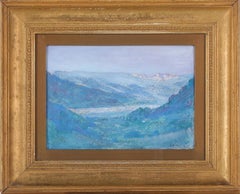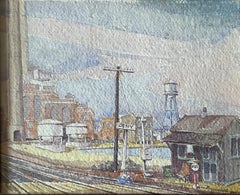Margaret Wherry Ziegler Landscape Drawings and Watercolors
Margaret Wherry Ziegler was born in Cincinnati, Ohio, in 1909. At a young age, she traveled with her parents to the Philippines, Japan, India, Italy, Greece and Europe. Ziegler studied art at the Cincinnati Art Academy, Minneapolis Art Institute, the University of the Philippines and the California College of Arts and Crafts. While in Japan, she studied Japanese brush painting. During her career, she exhibited widely on the Monterey Peninsula and was an award winner in many venues. In 1933, she married James Ziegler in Yokohama, Japan. During World War II, she spent time teaching children in the Michigan Public School system. Ziegler moved with her husband and two children to Carmel Valley (on the Monterey Peninsula) in 1956. In 1958, she became an Artist Member of the prestigious Carmel Art Association and remained a member throughout her life.
(Biography provided by Robert Azensky Fine Art)1960s American Impressionist Margaret Wherry Ziegler Landscape Drawings and Watercolors
Paper, Watercolor
Early 1900s American Impressionist Margaret Wherry Ziegler Landscape Drawings and Watercolors
Paper, Watercolor, Cardboard
1910s American Impressionist Margaret Wherry Ziegler Landscape Drawings and Watercolors
Paper, Watercolor
21st Century and Contemporary American Impressionist Margaret Wherry Ziegler Landscape Drawings and Watercolors
Paper, Gouache
Early 1900s American Impressionist Margaret Wherry Ziegler Landscape Drawings and Watercolors
Paper, Watercolor, Gouache
Early 20th Century American Impressionist Margaret Wherry Ziegler Landscape Drawings and Watercolors
Paper, Watercolor
Early 20th Century American Impressionist Margaret Wherry Ziegler Landscape Drawings and Watercolors
Watercolor
Early 20th Century American Impressionist Margaret Wherry Ziegler Landscape Drawings and Watercolors
Watercolor
1910s American Impressionist Margaret Wherry Ziegler Landscape Drawings and Watercolors
Watercolor, Gouache
Mid-20th Century American Impressionist Margaret Wherry Ziegler Landscape Drawings and Watercolors
Paper, Watercolor
1950s American Impressionist Margaret Wherry Ziegler Landscape Drawings and Watercolors
Paper, Watercolor, Gouache
1920s American Impressionist Margaret Wherry Ziegler Landscape Drawings and Watercolors
Paper, Watercolor
1990s American Impressionist Margaret Wherry Ziegler Landscape Drawings and Watercolors
Watercolor


